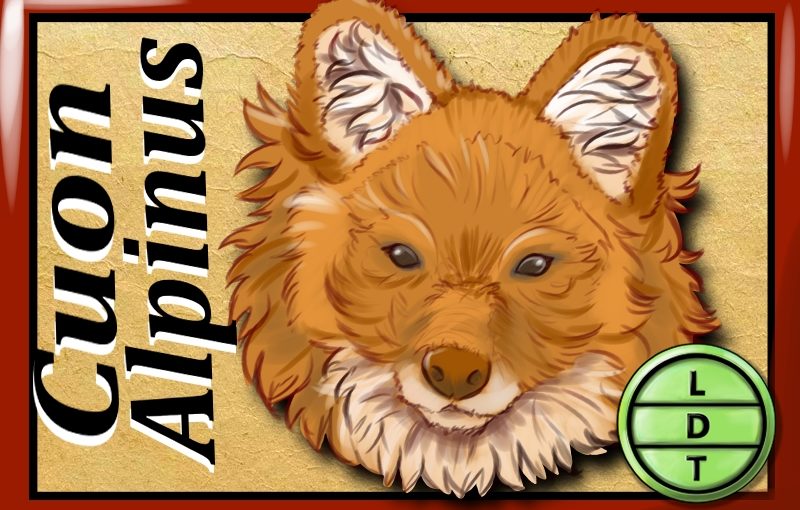“…and today we’re talking about a canine that whistles while it works. But more on that later…”
When you’re a predator that has to compete with leopards and tigers, you’re in for an uphill battle. If you’re smaller, slower, and not as stealthy as other carnivores in the mountain forests of Asia, you better have something else up your sleeve. For one courageous canine, the road to victory is one traversed with friends. Only by jolly cooperation and clear communication do these intrepid doggos feed their families. But sometimes living and working together is your best shot at thriving in Life, Death, and Taxonomy.
Measure Up
Length – 3 ft (0.91 m) – If each of the islands that make up Indonesia (17,000 islands) represented one foot, how many dholes would go into the length of each of these one foot islands in a row? Hint: Indonesia is a collective 1,904,569 square kilometres (735,358 square miles). Answer: 5,666 dholes
Weight – Males are slightly larger at 15 to 21 kg (33 to 46 lb) – 40 lbs – A country’s ability to produce electricity is measured in gigawatts. If the amount of gigawatts India is able to produce (300) were each one pound, how many dholes would go into it? Hint: In 2008, a DeLorean was converted to run on electricity. It was capable of reaching at least 88 mph but it stall can’t hope to ever produce anything close to 1.21 gigawatts. Answer: 7.5 gigawatts
Major Fact
- You’ve heard of dog whistles but have you heard of whistling dogs?
- Dholes are prolific vocalists with a wide range of calls that help them communicate with one another.
- However, unlike your canine companions or wolfs, dholes don’t bark or howl.
- Instead they let out a series of siren songs when they want to share their feelings and spill the tea.
- Dholes are extremely social animals, even more so than grey wolves that live in packs.
- Some researchers think this is because dholes are able to spend less time fretting about seasonal food scarcity.
- Like wolves, dholes hunt and live in groups and coordinate movement and attacks with body language and vocalizations.
- When they attack they will scream a war cry that’s described as a KaKaKaKAA.
- When they are socializing, they might perform sounds and body language similar to your dog at home.
- When they want someone to give them food they’ll whine.
- They’ll warn others to back off with a growl.
- They’ll scream and chatter when alarmed.
- And they’ll yap when startled or hurt.
- They will also put their arms and shoulders forwards and down with their tail in the air when they want to play.
- They smile with their mouth closed when they are friendly or submissive.
- They smile with their mouths open when they want to play.
- Finally, when they are moving through thick brush they stay together by whistling.
- We aren’t sure how they make this sound.
- It sounds like a whistle like air pacing through an opening in the mouth.
- But it could be a short high pitched whine.
- It’s used to coordinate movements when the dholes can’t see each other through thick underbrush.
- My theory is that a whistle is less assuming while hunting in a forest full of birds and things than barks or whines would be.
Other hunting facts…
- They are slower than other canines, like foxes that hunt alone.
- However, they often chase prey for longer distances.
- They take turns with part of the group sprinting ahead after prey while others maintain a slower, restful pace behind.
- Dholes will often lead prey to bodies of water where their movement is hindered and can exhaust prey more quickly.
- When they catch up to small prey under 50 kilograms, they will kill and eat them quickly.
- Large prey takes longer to bring down.
- Pray like deer is taken down with one dog biting it’s nose while the rest bring down it’s haunches and back legs.
- In some instances, they will attack the eyes to blind prey.
- Dholes don’t go for kill bites on the throat or the back of the neck.
- Instead, they disembowel prey and allow them to bleed out.
- Wolves will allow alpha pairs to eat first but dholes feed their pups first and then the rest of the clan eats.
- They will also return to dens and regurgitate food for mothers and young pups that stayed behind.
Outro
Like the wiley Dhole, we like to work together. Especially when it comes to making the best measure up segment we can. I’ll find the facts, Carlos will struggle through the math, and all you have to do is record the intro. Just say, sing, chatter, or bark the words measure up into your phone’s recording app and email it to LDtaxonomy dot com! Thanks for listening and working together with us!

